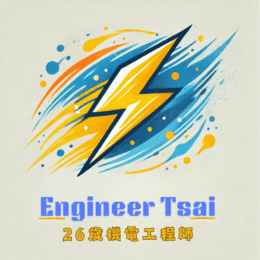▶️ How does an AC generator produce electricity?
What Is an AC Generator?
An AC generator—also known as an alternator—is a device designed to produce alternating current (AC) electricity. Unlike a DC generator that outputs current in a constant direction, an AC generator produces current that changes direction and magnitude over time.
AC is the primary form of electricity used in households and industries, mainly because it can easily be transformed to different voltages using transformers and is more efficient for long-distance transmission.
How Is Electricity “Generated”?
The key lies in Faraday’s Law of Electromagnetic Induction. When a conductor moves through a magnetic field—or when the magnetic field around a conductor changes—voltage is induced across the conductor. If the conductor forms a closed loop, an electric current will flow. That’s how mechanical motion is converted into electrical energy.
In an AC generator, this process happens by rotating a coil within a magnetic field—creating continuous changes in magnetic flux, which in turn generates electricity.
Breaking Down the Structure: Four Main Components of an AC Generator
A typical AC generator consists of the following major parts:
🔹 Rotor
The rotating component—usually equipped with magnets or coils—that creates the magnetic field. As the rotor spins, it causes a changing magnetic flux around the stator.
🔹 Stator
The stationary component, typically made of coils wound on an iron core. As magnetic flux changes through the stator coils, an induced voltage is generated based on Faraday’s Law.
🔹 Slip Rings and Brushes
These components transfer the AC voltage generated in the rotor to the external circuit without interrupting the rotation.
🔹 Mechanical Input
This is the driving force—provided by hydraulic turbines, wind turbines, steam engines, or internal combustion engines—that keeps the rotor spinning.

How AC Electricity Is Generated: Magnetic Field × Rotation × Time
When a coil rotates at a constant speed within a magnetic field, the amount of magnetic flux passing through the coil changes over time:
- When the magnetic field is perpendicular to the coil, the induced voltage is at its maximum.
- When the magnetic field is parallel to the coil, the induced voltage drops to zero.
- As the rotation angle changes, the induced voltage follows a sine wave pattern.
This variation creates an alternating current (AC), whose frequency depends on the rotational speed. For example, a rotation of 60 times per second produces a 60Hz current.
🔍 Reminder: It’s not always the magnet that needs to move—the coil can rotate instead. What matters is the relative motion that causes a change in magnetic flux!
Why Do We Use AC Electricity?
There are several key reasons why most modern power systems use AC:
- Easy to transform and transmit: AC voltage can be stepped up or down efficiently using transformers, making it ideal for long-distance transmission.
- Efficient generation: AC generators are structurally simple and mechanically reliable.
- Mature infrastructure: Most household and industrial devices are designed for AC power, supported by well-established systems.

Real-World Applications: Where Are AC Generators Used?
🔹 Hydropower Plants
Water flow spins a turbine, which drives a generator to produce AC electricity.
🔹 Wind Turbines
Wind turns the rotor blades, causing the generator inside to rotate and generate power.
🔹 Automotive Alternators
In vehicles, the engine powers an alternator that supplies electricity and charges the battery.
🔹 Backup Generators
Provide emergency power during outages—common in hospitals, data centers, and critical infrastructure.
DIY Experiment: Feel the Power of AC for Yourself!
📌 What You Need:
- A small magnet
- A coil (dozens of turns of insulated copper wire)
- An LED light
🧪 Steps:
- Connect the LED to both ends of the coil.
- Quickly move the magnet through the coil.
- Observe the LED flashing.
- Try moving the magnet back and forth—the LED flashes twice due to alternating current.
✅ Conclusion:
This simple setup demonstrates the basic working principle of a hand-cranked AC generator using electromagnetic induction!

Conclusion & Further Reading
An AC generator is more than just a component in the power system—it plays a crucial role in modern energy conversion. Whether it’s hydro, wind, or thermal power, from urban grids to car charging systems, AC generators are everywhere. Understanding how they work, especially through the lens of Faraday’s Law of Electromagnetic Induction, enables us to create more efficient, innovative, and reliable energy solutions.
📌 Further Reading
🔹 Faraday’s Law of Electromagnetic Induction: Simple Guide with Real-World Uses
Explore the core principle behind AC generation—from changing magnetic flux to induced voltage.
🔹 Magnetic Fields and Electricity: The Hidden Force Powering Modern Technology
Learn how magnetism and electricity interact to form the foundation of electromagnetism.
🔹 Transformer Voltage Step-Up & Step-Down: What You Need To Know
Understand how transformers adjust voltage for power distribution after generation.
🔹 How Does Wireless Charging Work? The Science Behind Electromagnetic Induction (Coming Soon)
From smartphones to electric vehicles, discover how AC and coil design enable wireless power transfer.


